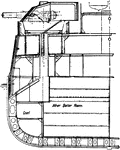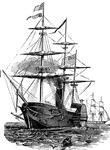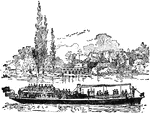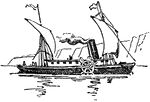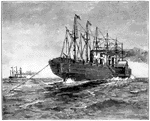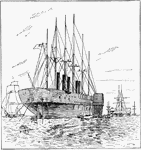This transportation ClipArt gallery offers 103 illustrations of steam-powered ships, including many images of the original steam boat built by Robert Fulton.

Barge with Diving Bell
"Sectional view of diving bell and barge, employed on the River Clyde. All the appliances are worked…

Baton Rouge, LA
An illustration of Baton Rouge, Louisiana from the Mississippi River. Baton Rouge is located in the…

British Navy Hood Battle Cruiser
The Royal Navy's Hood class battle cruiser launched on 1918. The cruiser was used as an anti—torpedo…

British Navy Renown Battle Cruiser
The British Royal Navy's Renown battle cruiser design launched in 1916. The cruiser is a modified design…

Japanese Imperial Navy Kongo Class Battlecruiser
The illustration of the Kongo class battlecruiser by the Japanese Imperial Navy. The ship was designed…

Japanese Imperial Navy Tatsuta Battlecruiser
Japanese Imperial Navy Tatsuta battlecruiser launched in 1918. One of the first ships to be armed with…

United States Navy Omaha Class Battlecruiser
A U.S. Navy Omaha class battlecruiser launched in 1920. The top speed of the cruiser is 35 knots (40…

Battleship Massachusetts
Ships designed to engage similar enemy warships with direct or indirect fire from an arsenal of main…

British Royal Navy Destroyers and Flotilla Leaders Battleship
"These vessels (destroyers and Flotilla leaders) gradually increased in size and power, and war requirements…

British Royal Navy H.M.S. Erebus Battleship
British Royal Navy battleship, H.M.S. Erebus. The ship was completed in 1870, at Napier shipyard as…

Caio Duilio Battleship Italian Navy
Italian navy's Caio Duilio battleship launched in 1913. The ship was used during World War I and II.

Bretagne Class Battleship French Navy
The Bretagne class battleship built by the French navy during 1913. The ship has a top speed 20 knots…

Hindenburg German Navy Battleship
German Navy Battlecruiser, SMS Hindenburg. The ship was launched in 1915, and used during World War…

Iron Duke Class British Battleship
A 1912 British navy battleship Iron Duke class. Battleships in this class is operated by steam and have…

Russian Navy Battleship
"Four battle cruisers were launched in 1915, but they had not been completed up to 1921. On a displacement…

United States Navy Arizona Battleship
An illustration showing USS Arizona. USS Arizona was a Pennsylvania class battleship, built by U.S.…

Massachusetts Battleship United States Navy
USS Massachusetts commissioned by United States Navy in 1942. The ship was used during the World War…

Bellaire, Ohio
"Bellaire, O.- Steamboats conveying troops and munitions of war for the Federal forces on the Great…
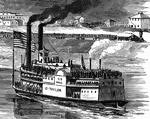
Bellaire
"Bellaire, O.- Steamboats conveying troops and munitions of war for the Federal forces on the Great…
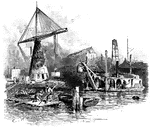
Dredging Boat and Derrick
An illustration of a dredging boat (right) and a derrick (left). A derrick is a lifting device composed…
Longitudinal section of the Caronia
A longitudual cross-section showing the interior of the Caronia.

Clermont
The Clermont, Fulton's experiment boat, was constructed under the personal supervision of Fulton,…
Hopper Dredger
"Longitudinal section of hopper dredger, employed on the River Clyde. The vessel steams to place of…
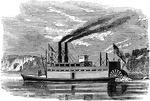
Ellet's Stern Wheel Ram
Charles Ellet, Jr. (1 January 1810 – 21 June 1862) was a civil engineer and a colonel during the…

Ship Engine
Originally developed to improve the engine's capabilities. Found in many 19th century ships equipped…
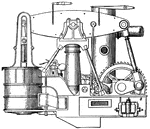
Ship Engine
A Geared Beam Engine developed in 1855. Applied force on a piston pushes down the rod, making the engine…

Turbine Engine
The inner workings of the Carmania. A description of how the ship gets power in order to move on the…

The Faraday Laying the Atlantic Cable
The CS Faraday was a cable ship built by the Siemens Brothers Company in 1874.

Fitch's Steamboat
John Fitch (January 21, 1743 – July 2, 1798) was an American inventor, clockmaker, and bronzesmith…

Foote's Gunboat Flotilla in 1862
USS Pittsburgh (1861) was a City class ironclad gunboat constructed for the Union Navy during…

Fulton's Clermont
The first commercial steamboat, the North River Steamboat later known as the Clermont.

Fulton's Clermont
In 1807, Fulton and King built the first commercial steamboat, the North River Steamboat (later…
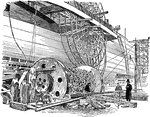
Great Eastern
"A midship view of the Great Eastern, showing one of the paddle-wheels and the launching gear." -Gordy,…

Hudson River Steamboats
An advertisement taking from the New York Evening Post of June 1813, with a copy of a picture…
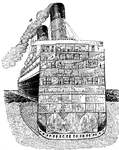
Ocean Liner
The Carmania was a ship built in 1905 built in Britain by John Brown & Company. She was designed by…

Wreck of the Maine in Havana Harbor
USS Maine (ACR-1), the first ship of the United States Navy to be named for the state of Maine, was…

Projection Showing Position of Bow and Keel of the Maine
USS Maine (ACR-1), the first ship of the United States Navy to be named for the state of Maine, was…

United States Battleship Maine
USS Maine (ACR-1), the first ship of the United States Navy to be named for the state of Maine, was…

Modern Sound Propeller
"A steamboat is a boat or vessel propelled by steam acting either on paddles or on a screw. The term…
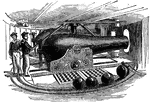
Interior of the Monitor's Turret
USS Monitor was the first ironclad warship commissioned by the United States Navy. Monitor…


